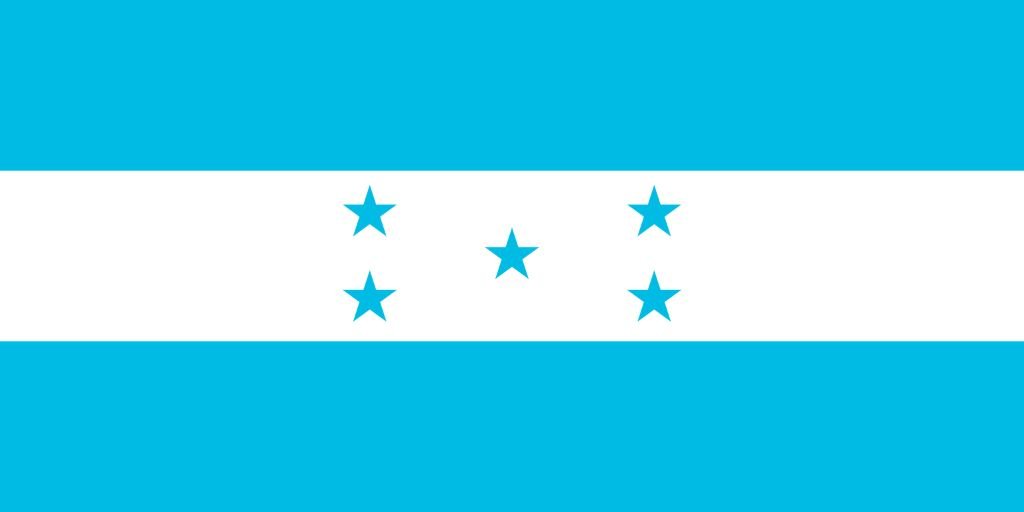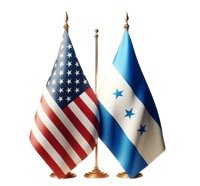The flag of Honduras

The flag of Honduras is one of the most representative patriotic symbols of the Central American country. With its three distinctive colors and rich history, the flag reflects the identity and pride of the Honduran nation.
But what does each color of this flag really mean? And how did this national emblem come about? In this article, we will delve into the meaning of the colors and the history behind the flag of Honduras.
Color and design of the flag of Honduras
The flag of Honduras is composed of three horizontal stripes that extend along its design. These strips are arranged in the following order:
- A turquoise blue stripe at the top.
- A white stripe in the center.
- A turquoise blue stripe at the bottom.
Within the central white stripe, there are five blue stars arranged in the shape of an arc. Each star is equidistantly separated from the others, creating a harmonious arrangement in the flag’s design.
What is the meaning of the 3 colors of the Honduran flag?
Turquoise Blue:
The two blue stripes flanking the flag symbolize the two oceans that bathe the coasts of Honduras: the Atlantic Ocean and the Pacific Ocean.
This blue color also represents the sky that covers the Honduran territory and the aspirations and dreams of its people.
2. White:
The white color, placed between the two blue stripes, symbolizes peace and integrity. It represents the purity of the nation’s ideals, the desire for unity and harmony among its inhabitants.
It is also a reminder of the country’s commitment to justice and freedom.
The five blue stars located in the central white stripe of the Honduran flag represent the five countries that formed the Central American Federation.
These countries are: Honduras, El Salvador, Costa Rica, Nicaragua and Guatemala. The arrangement of the stars on the flag symbolizes the union and brotherhood of these Central American nations.
What is the history of the National Flag of Honduras?
The National Flag of Honduras was officially adopted on February 16, 1866. Its design was inspired by the flag of the United Provinces of Central America, a political entity that existed in the early 19th century and of which Honduras was part.
Over the years, the design of the flag has undergone some modifications, but always maintaining the essence of the blue and white stripes.
The five stars that adorn the white stripe were added to symbolize the five countries that made up the United Provinces of Central America in 1866.
History of the Five Stars on the Honduran Flag
The United Provinces of Central America, also known as the Central American Federation, was a political entity that existed between 1823 and 1841. This federation was formed after the independence from Spain and the brief annexation to Agustin de Iturbide’s First Mexican Empire.

The main motive for forming this federation was the idea of joining forces and resources to ensure the stability and prosperity of the region after its independence. In addition, there was a strong sense of regionalism and brotherhood among these territories, which shared similar colonial origins, traditions and historical contexts.
In 1823, after the dissolution of the Mexican Empire, the provinces of the Captaincy General of Guatemala proclaimed their independence and formed the Central American Federation. On November 22 of the same year, a federative coat of arms and flag were adopted. The flag was blue and white, colors that were derived from those used by the United Provinces of the Río de la Plata (now Argentina) and symbolized the liberal ideals of the time.
With the passage of time and due to political, economic and territorial differences, the federation began to show signs of fracture. Eventually, confrontations and conflicts led to the disappearance of the federative entity and the consolidation of the independent states we know today.
The incorporation of the five stars in the white stripe of the Honduran flag, representing the five countries that made up the Central American Federation, is a tribute to that past union and a symbol of Central American brotherhood.
Although the federation no longer exists, the stars persist as a reminder of that era and of the aspiration for union among the nations of Central America. The current flag of Honduras was adopted on March 7, 1866, and since then, the stars have been a fundamental part of its design.
What is the meaning of the flag?
Beyond the colors and stars, the flag of Honduras is a symbol of unity, identity and patriotism.
Every time it flutters in the wind, it is a reminder of the indomitable spirit of the Honduran people, their rich history and their unwavering desire to thrive in a promising future.
The flag of Honduras is much more than just a piece of cloth. It is a reflection of the soul of a nation, full of history, culture and meaning.
Understanding the values and principles it represents, one not only appreciates its aesthetic beauty, but also the deep emotional connection it has with every Honduran.






